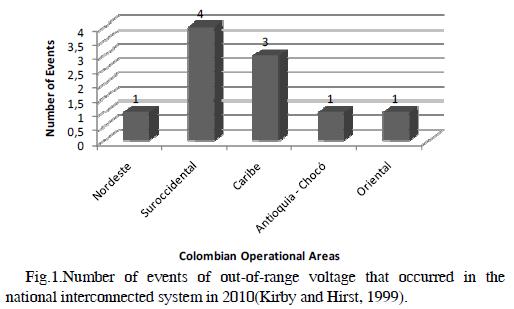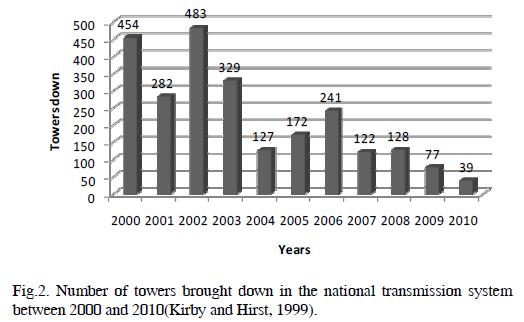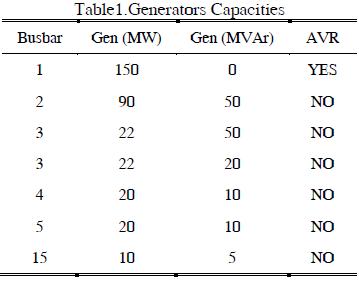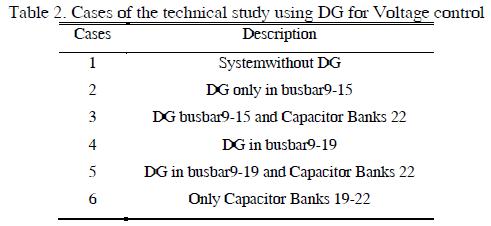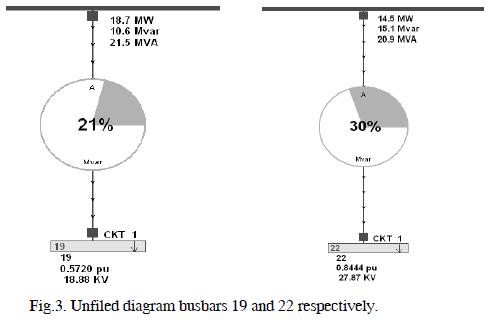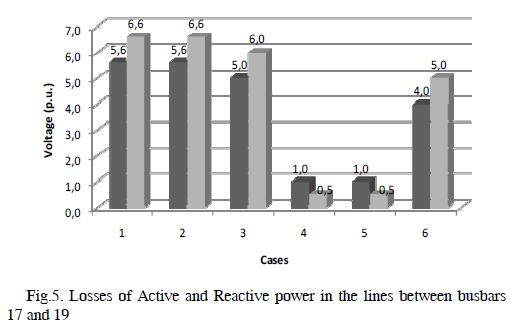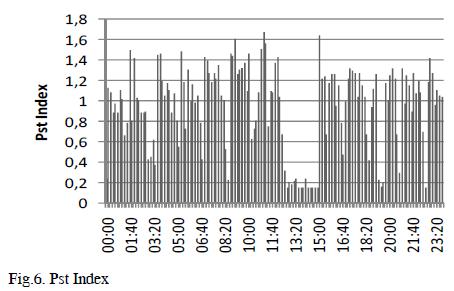Serviços Personalizados
Journal
Artigo
Indicadores
-
 Citado por SciELO
Citado por SciELO -
 Acessos
Acessos
Links relacionados
-
 Citado por Google
Citado por Google -
 Similares em
SciELO
Similares em
SciELO -
 Similares em Google
Similares em Google
Compartilhar
Ingeniería e Investigación
versão impressa ISSN 0120-5609
Ing. Investig. v.31 supl.2 Bogotá out. 2011
Contribution of Distributed Generation to Voltage Control
Contribución de la generación distribuida para controlar la tensión
A. Arango-Manrique1 , S. Carvajal-Quintero2 , S. Arango-Aramburo3
1 Corporación Centro de Investigación y Desarrollo Tecnológico del Sector Eléctrico- CIDET, (571)3382323 Colombia (e-mail: aarangoma@unal.edu.co).
2 MSc. in Electrical Engineering, Universidad Nacional de Colombia, Associate Professor Universidad Nacional de Colombia, Sede Manizales. sxcarvajalq@unal.edu.co
3 Universidad Nacional de Colombia, Sede Medellín. Energy Institute, (email: saarango
ABSTRACT
The power system operator must ensure a secure electricity supply, reliable and with quality while maintaining frequency and voltage profiles stable and within the ranges required by the specific regulations for each country. Voltage control and reactive-power management are two aspects of a single activity that both supports reliability and facilitates commercial transactions across transmission networks. Distributed Generation (DG) provides benefits for the voltage control because is located close to consumption centers, as well to helping congestion relief on the transmission and distribution grids. This paper presents an analysis about the pertinence of the implementation of distributed generation systems for voltage control service in the interconnected system in Colombia. This analysis is based through grid simulations in a fraction of the sub-region of the CQR with PowerWorld. The simulation considers low operating voltage levels because of the presence of inductive loads. The results show that by connecting Distributed Generation, voltage level increases and reduce power and reactive losses.Keywords: Distributed Generation, Reactive Power, Voltage Control.
RESUMEN
El operador del sistema de potencia debe asegurar un suministro de electricidad seguro, confiable y con calidad mientras mantiene los perfiles de tensión y frecuencia estables y dentro de los rangos requeridos por la regulación específica de cada país. El control de tensión y el manejo de la potencia reactiva son dos elementos de una misma actividad que tiene como fin servir de soporte a la confiabilidad y facilitar las operaciones en las redes de transmisión. La Generación Distribuida (GD) proporciona beneficios para el control de tensión porque se conectada cerca de los centros de consumo y de esta manera ayuda a la congestión en las redes de transmisión y en la redes de distribución. Este artículo presenta un análisis acerca de la pertinencia de la implementación de sistemas de GD para el servicio de control de tensión en el sistema interconectado en Colombia. Este análisis se realizó usando simulaciones con el software PowerWorld en una región del sistema de potencia, específicamente en la región de Caldas, Quindío y Risaralda (CQR). Los resultados de las simulaciones muestran que al conectar GD, los niveles de tensión se incrementan y las pérdidas de potencia activa y reactiva se reducen.Palabras claves: Generación Distribuida, Control de Tensión, Potencia Reactiva.
1. Introduction
Distributed Generation(DG) has advantages in power systems. It provides power input (active and reactive) close to consumption centers (Viawan and Karlsson, 2008).The contribution of reactive power provided by the DG to the grid improves, among other characteristics, the voltage in the busbar where these generation plants connect (Jóos et al, 2000)(Nasser and Kurrat, 2009).When DG provides reactive power and there is voltage control, it is considered as a localized control of voltage output. The DG actually improves the voltage magnitude in the busbar in the point where DG connects. DG has implications and influence on the neighboring busbars, making this control into a regional control, i.e., DG improves the conditions at a specific busbar, which is reflected in the voltage magnitudeon the nearby busbars (Gómez Expósito, 2002). We propose to use distributed generators to improve voltage profiles and reduce power and reactive losses in the national electrical power system.
In this paper, we perform a simulation study of the influence of DG on the voltage magnitudes in a sub-region of the Colombian power market. The sub-region is known as Caldas, Quindío and Risaralda (CQR), which is part of the Suroccidental operating area of the national interconnected system.
In CQR there are voltage stability problems due to the connection of highly inductive loads, mainly due to industrial activities. We propose and evaluate the use of DG with renewable resources to alleviate this problems and voltage control in the region. The proposed DG plants are small hydro plants and biofuel thermal plants. The choice for these technologies is based the available of water resources and raw matter for the creation of biofuelsin the area.
The paper is organized as follow. The next section introduces the concept of ancillary services. Thereafter, section III presents a brief explanation and use of DG in Colombia. Section IV shows the grid simulation study to test out the benefits of DG for voltage and reactive control in the CQR. The simulations are carried out in Power World. Section V concludes.
2. Ancillary services
The deregulation of the electricity sector in different countries have led to consider electricity as a commodity, where the end user is now a costumer who requires not only secure of supply but also high levels of reliability and quality (Bacon and Besant-Jones, 2001).Reliability and quality should be understood as the maintenance of voltage and frequency levels within limits that depend on the regulations of each country(Bacon and Besant-Jones, 2001).
Maintaining a stable operating power system is not an easy task. Voltage and frequency do not remain constant, as a result of the continuous variation of the demand for both active and reactive power(Bacon and Besant-Jones, 2001).As electricity markets cannot function if the power system does not operate safely, it is necessary to consider the deployment of services that enables the system operator to maintain the integrity and stability of the interconnected system, as well as the electric power quality (Bacon and Besant-Jones, 2001).These technical support services of the grid are known as Ancillary Services and support the daily electricity market. The services that stand out for their implementation in deregulated markets in the world are Voltage Control, Frequency Control and Black Start (Bacon and Besant-Jones, 2001).
These grid support services allow maintaining the frequency and voltage profiles stable within the required ranges. It also helps the power system operator to meet the operational requirements for the electricity supply to be continuous and high-quality as required by end users(Bacon and Besant-Jones, 2001).
Voltage control is related to reactive power supply in the system busbarsthrough the use of different equipment and technologies (Kirby and Hirst, 1999). It is an ancillary service provided locally, which allows maintaining the voltage on a node or busbar within the values required by the regulator.
The control exerted on a node benefits the nearby busbars and improves the voltage profile, while reducing active and reactive power losses that occur in the lines interconnecting said busbars(Kirby and Hirst, 1999). This control, therefore, can be provided regionally favoring the loads connected in the nearby busbars.
When there are evident wave disturbances in the voltage, there are equipment breaks due to improper loads work. These disturbances trigger a voltage collapse in the system to the point of a widespread blackout that affects the production and operation of loads connected to the system (Kirby and Hirst, 1999).
The Colombian power system operator usescentralized generators for reactives and voltage management control. However, these generators, due to operational constraints, suffer an active nominal power decline at times when the reactives delivery or absorptionalters. This condition reduces the net generation capacity which can affect the power system security rates (CREG, 1995).
Fig. 1 shows the number of events per area that violate operational voltage limits allowed by the regulator in 2010.Although the Colombian power system reduced by 53% the occurrence of such violations in 2010 compared to 2009, it is important to increase the reliability and continuity of electricity supply, reducing voltage excursions.
The Suroccidental is the area where they had the greatest number of events of tension out of range, this is given for technical reasons since it is an industrial area with the highest demand, but mainly because the networks of transmission in this region annually suffers terrorist attacks . Fig. 2 shows in Colombia, the number of towers down in the past 10 years, which shows that the Colombian power system has operated under high unavailability of transmission system elements due to attacks on the network.
A solution that is being researched (XM Los expertos en mercados) to carry out voltage and reactive control is DG. By connecting DG to busbars where there are voltage collapses, a better regulation is achieved by increasing magnitudes and lines congestion due to reactive flows (Kirby and Hirst, 1999).DG is a generation method in which electricity generating units with relatively small capacities are installed close to the loads, or consumption centers (Viawan and Karlsson, 2008).
3. Distributed generation
DG is the generation and storage of electrical energy on a small scale, as close to the load center as possible (Iberdrola Renovables, 2010). DG is not limited to the use of fossil fuels; in fact, in some regions there are significant renewable energy sources integrated into the power system through the use of wind turbines and biomass combustion. Hybrid systems combine fossil fuels and renewable resources technologies because the latter generally do not produce constant electricity, necessary condition for that (XM Los expertos en mercados).
DG can be used with the aim of providing ancillary services such as frequency and voltage control (Iberdrola Renovables, 2010). The voltage control has two general objectives: (a) to provide continuous voltage regulation and (b) to maintain an adequate reactive spinning reserve margin for providing support to the power system against contingency occurrences (Nasser and Kurrat, 2009).
In Colombia there are currently around 150 MW of DG (Cardell et al, 1998). However, this DG is not used to control voltage because there is not a regulation that allows the National Dispatch Center to have detailed technical information to quantify the quality and continuity of the DG. Furthermore, it is important for the system operator to know that information since DG should be controlled, since it helps to reduce grid congestion, but it can also damage frequency through power counter flows (Cardell et al, 1998).
Although the regulatory framework does not consider DG generation as a generation option, there are some industries such as oil, cement, and sugar mills, among others, which count on machines that allow them carrying out self-generation processes and cogeneration in some cases (Cardell et al, 1998).
4. DG evaluation for voltage control.
DG is an alternative currently for voltage control under investigation. The key part is the installation of DG near the loads with high inductive value, since its effectiveness to increase voltage and reduce active and reactive power losses within an interconnected area of influence has been proven.
In order to see how DG can contribute to ancillary service voltage control, we implementa powersub-system with different voltage levels (220 kV, 115 kV, and 33 kV). We also include in the evaluation thevoltage and reactive power flow behavior when connected to the DG.
Loads connected to the grid have a highly inductive value, simulating realistic industrial loads. We simulated five cases to evaluate voltage control and reactive flow with DG, in addition to the original case. The DG connected has a capacity of 10 MW and the AVR (Automatic Voltage Regulator) is calibrated so that they can regulate the Q (reactive power) flow from -8 MVAr to 8MVAr.
For the connection, we have chosenthe busbars that have voltage values outside the ranges required by the Colombian law. Under normal operating conditions, the voltages in the busbars of 110 kV, 115 kV, 220 kV and 230 kV shall not be less than 90% or 110% above the nominal value [13].Additionally, we evaluated the behavior of the system lines where there are reactive flow problems, and i.e. where the congestion and reactive power are located.
The system evaluated, this systemhas 22 busbars, two connected to 220 kV, six of 115 kV and 14 connected to 33 kV.The system has seven generators. The highest-capacity generator produces 150 MW and since it is connected to the Slack busbar its MVAr generation is conditioned to the system losses. Table 1 shows the capacity of the grid generators and table 2 shows the summary of the simulated cases, next, we describe the simulation cases in which the contribution of DG on voltage control and reactive power flow are examined.
Fig. 3 shows the technical information of busbars19 and 22, The busbar 19 has a nominal voltage of 33kV, however the full-load voltage is reduced to 18.88 kV (0.57 pu.), i.e. the bar 19 has a voltage reduction equal to 57.2% and voltage regulation of 76%, these data show a large voltage drop, which affects the proper functioning of the installed loads in this busbar and in the busbars near. The bar 22 has less voltage reduction (15.5%), but It has a power factor of 0.7. Since the total power supplied by an infinite bus to the load is 3 VaIaCosθ, a low power factor is accompanied by an increase in the current Ia. For the same load, the increase in the current owing to decreased power factor results not only in a greater voltage drop over the transmission line but also in greater power losses.
A. Simulations results:
Fig 4 shows the simulation results of the voltage in busbars19 and 22. Voltage behavior in the busbars 19 actually has the lowest voltage magnitude with respect to the other system busbars. It also shows the limit percentage of the overloaded busbars, and finally the reduction in active and reactive power losses in the busbars whenDG is connected.
Voltage in busbar 19, greatly improves when it is connected to DG as observed in cases four and five. For case six in which a BC is connected to the busbar, there was voltage increase, but this is not as significant as the one that occurs when DG isconnected.
For voltage control in this busbar it was necessary to connect a Distributed Generator since the behavior of the BC installed does not provide the active power required for the load.
In the case of busbar 22, voltageis improved when DG is installed. It is important to state that for voltage control in this busbar it is possible to use the BC, since it shows a favorable behavior in thebusbar voltage magnitude.For cases in which DG is connected to nearby busbars, the voltage magnitude increases to values of 0.95 p.u. improving the voltage regulation in that busbar and therefore the regulation and control is expanded to provide a regional voltage control.
The lowest line overload percentage occurs when DG is implemented (Fig. 5.). The activepower generated in some busbars, in addition to that of large power plants, allows the decongestion of transmission and distributionlines.
DG provides a local control with regional consequences, as observed in Fig. 1 and Fig. 2. The most notorious consequences are voltage rise; transmission lines overload, and reduced active and reactive power losses.Via simulations and analysis of the grid in the sub-area CQR, we observe that the productions of active and reactive power provided by distributed generators improve the operation of the power grid.
DG causes an increase in the voltage levels so can worsen the power quality in that area. We analyze the behavior of the system to connect DG to improve operating conditions, the voltage increases and therefore exceed the allowed limits, which may result in an interconnected system from damage to equipment to a voltage collapse as the amount of reactive power and real network topology.Operators of electric power systems generally oppose the installation of the DG, because these uncontrolled sources of generation can cause serious problems in the power quality. Currently, this idea is changing because of intelligent networks, to be known as Smart grids. Smart grid is a type of electrical grid which attempts to predict and intelligently respond to the behavior and actions of all electric power users in order to efficiently deliver reliable, economic, sustainable and with the high levels of power quality.
5. Power quality and DG
The term power quality should take into account different aspects of the behavior of a power system, the fundamental function of which is to supply loads economically and with adequatelevels of continuity and quality (Verde et al, 2009).
The disturbances of voltage are associated with under voltages and overvoltage's, among other phenomena that distorting the waveform of the voltage. The power quality depends on the specific needs of theconsumeror load that isconnected to the network (Ramirez et al., 2006).
Percebility Short Time (PST) is the indicator used in Colombia for judging the severity of the voltage deviations (CREG 024, 2005). PST is an indicator of the visibility of equipment or system to voltage fluctuations for 10 minutes IEC-61000-4-15 (2003-02). To measure this indicator is mandatory for agents of transmission and distribution, specialized sampling equipment installed in busbars with voltages above 13200V (CREG 016, 2007).
The voltage level of the system determines the value of the PST to higher voltages and equal to 220kV, the index should be 0.8 PST and PST voltages below the rate should be 0.9. Fig 6 shows the record over a period of 24 hours of a device that measures the rate in the three phases PST power system in an operational area bar CQR. The selected bar has 115 kV, which is installed between their loads a steel. Fig. 6 shows the PST rate usually exceeds the value of 0.9 in its daily operation, however, between 13:00 and 15:00 PST the rate decreases to 0.2 due to fall further in operating furnaces to melt metal alloys and chemical development.
DG is the generation and storage of electrical energy on a small scale, as close to the load center as possible (Iberdrola Renovables, 2010). DG is not limited to the use of fossil fuels; in fact, in some regions there are significant renewable energy sources integrated into the power system through the use of wind turbines and biomass combustion. Hybrid systems combine fossil fuels and renewable resources technologies because the latter generally do not produce constant electricity, necessary condition for that (XM Los expertos en mercados).
The problem of power quality seen in Figure 6 is presumably due to increased consumption in highly inductive loads, so the power factor decreases, the current increases and creating distortions in the voltage wave. All these problems affect the load that originates and nearby loads, especially those sensitive loads which are defined as one that requires a supply of high quality, that is, free of disturbances. The electronic devices are more susceptible to disturbances that traditional electromechanical equipment.
Industrials with DG have the potential to improve the performance of their equipment sensitive to the distortions in the voltage wave whose origin is outside of its facilities. Their interest is in energy dump of his generation to its sensitive equipment, even to the extreme benefit of the voltage sag, which is the interruption of short duration, commonly called micro-cutting. To exploit this possibility, the user must have an emergency scheme, despite the availability of non-essential load shedding. Moreover, for interruptions of long duration variation, the utility requires the DG can be is disconnected immediately to prevent the formation of isolated systems that can harm the process of restoration.
All these maneuvers are impossible with electromechanical devices; however, there are now devices that handle the operation principle of Smart Grids. These devices can detect these events by continuously monitoring and recording current and voltage information on all metered channels. In the moment of fault, there are currently electronic reclosers with records voltage sags, swells and interruptions. (ANSI/IEEE Std. 1159, 2009). In addition, all data can be downloaded on-site or remotely through communications interface.
6. Conclusions
Voltage and reactive control is an important ancillary service in the operation, quality, and safety of a power system.
It affects reliability; in particular, given that voltages must be maintained within an acceptable range for both customer and power system equipment to function properly. The movement of reactive power consumes transmission resources, which limits the ability to transport real power and worsens congestion in the grid. The movement of reactive power results in real-power losses.In this paper, we have shownDistributed Generation (DG) as an alternative to provide these services. Simulations experiments of the grid show that DG has proven to be efficient to increase voltage and decrease both active and reactive power losses within an interconnected area of influence. However, simulations also show that in bars with voltage levels above the allowed limits by the regulator, the installation of DG could actually worsen the problem and therefore compromised the stability of power system.
In order to contribute to grid support especially voltage control withDG, thebusbar that will be connected must be assessed, such evaluation results in an optimal location for DG and BC. The BC is an economical solution to improve the contribution of reactive in some places where is impossible connect DG.
Renewable generation can be used to provide the support services the grid needs, such as voltage control. However, it is requires to be used inhybrid systems that combine conventional resources and renewable energy sources. Hybrid systems maintain a constant active and reactive power supply, which facilitates the flow of these powers to the distribution grid. Thus, the congestion on transmission lines is reduced and the voltage in the busbars near the DG remains in thenominal values.
The international context shows that the DG technology is currently used as technicalgridsupport especially involtage control. Consistent with this paper, the implementation of programs have focused on studying the feasibility of installing generating units close the consumption centers,such that ancillary services are provided to improve security and reliability indices for all users.
In addition, DG can be used without damaging power quality taking in count that the distribution system must to have an electronic recloser. These devices allow to monitoring and to control in real time in order to maintain power quality. Currently, the use of these devices is becoming more common given that they allow diagnose equipment problems resulting from voltage sags or swells and identify areas of vulnerability, enabling you to take corrective action.
DG have less profitability compared to the large power generation stations, thus, it is necessary to consider alternative policies that incentive the construction of plants that use non-conventional and conventional small-scale sources in order to implement eco-friendly hybrid systems that can be improve environmental conditions of planet.
7. References
Bacon, R.W., and Besant-Jones, J., ''Global electric power reform, privatization and liberalization of the electric power industry in developing countries'', Annual Reviews of Energy and the Environment 26, Pages 331-359, 2001. [ Links ]
Cardell, J., Ilic, M., Tabors, R., ''Integrating Small Scale Distributed Generation into a Deregulated Market: Control Strategies and Price Feedback'', Laboratory for electromagnetic and Electronic Systems Massachusetts Institute of Technology for: US Department of Energy, Office of Utility Technologies, 1998. [ Links ]
CREG, Resolución CREG 025 de 1995, ''Código de Redes, Código de Planeamiento de la Expansión del Sistema de Transmisión Nacional'', 1995. [ Links ]
CREG, Resolución CREG 025 de 1995, ''Código de Redes, Código de Planeamiento de la Expansión del Sistema de Transmisión Nacional'', 1995. [ Links ]
Fila, M., Taylor, G.A., Hiscock, J., Irving, M.R., Lang, P., ''Flexible Voltage Control to Support Distributed Generation in Distribution Grids'', Universities Power Engineering Conference, 2008.UPEC 2008 . 43rd International, On page(s): 1-5, 2008. [ Links ]
Gómez Expósito A., ''Sistemas Eléctricos de Potencia'', ISBN: 8420535583 ISBN-13: 9788420535586, 2002. [ Links ]
Iberdrola Renovables S.A., ''Iberdrola renovables logra un récord histórico de producción eólica en estados unidos durante el segundo trimestre de 2010'', Disponible: http://www.iberdrola.es/. [ Links ]
Jóos, G., Ooi, T., McGillis, D., Galiana, F., Marceau, R., ''The Potential of Distributed Generation to Provide Ancillary Services, Power Engineering Society Summer Meeting, IEEE 2000, 10.1109/PESS.2000.868792, pp 1762-1767, 2000. [ Links ]
Kirby, B., Hirst, E., ''Ancillary Service Details: Voltage Control'', The National Regulatory Research Institute Columbus, Ohio, 1999. [ Links ]
Nasser , G. A H., and M. Kurrat, ''Distributed Generation Location and Capacity Effect on Voltage Stability of Distribution Grids'', IEEE Student Paper Conference, 5 pages, 2009. [ Links ]
Pecas, J., Hatziargyriou, N., Mutale, J., Djapic, P., Jenkins, N., ''Integrating distributed generation into electric power systems: A review of drivers, challenges and opportunities'', Electric Power System Research, vol. 77, pp 1189-1203, 2006. [ Links ]
Rodriguez Hernandez, A., ''La Generación Distribuida y su Posible Integración al Sistema Interconectado Nacional'', Taller sobre Generación Distribuida, 2009. [ Links ]
Viawan, F. and Karlsson, D.,, ''Coordinated Voltage and Reactive Power Control in the Presence of Distributed Generation''. Power and Energy Society General Meeting. - Conversion and Delivery of Electrical Energy in the 21st Century , pp 1-6, 2008. [ Links ]
XM Los Expertos en Mercados, Informes Anuales de Operación del Sistema y Administración del Mercado Eléctrico Colombiano 2000 - 2010 (In Spanish), [ Online ], available:http://www.xm.com.co. [ Links ]













